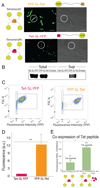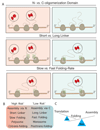Cotranslational protein assembly imposes evolutionary constraints on homomeric proteins
- PMID: 29434345
- PMCID: PMC5995306
- DOI: 10.1038/s41594-018-0029-5
Cotranslational protein assembly imposes evolutionary constraints on homomeric proteins
Abstract
Cotranslational protein folding can facilitate rapid formation of functional structures. However, it can also cause premature assembly of protein complexes, if two interacting nascent chains are in close proximity. By analyzing known protein structures, we show that homomeric protein contacts are enriched toward the C termini of polypeptide chains across diverse proteomes. We hypothesize that this is the result of evolutionary constraints for folding to occur before assembly. Using high-throughput imaging of protein homomers in Escherichia coli and engineered protein constructs with N- and C-terminal oligomerization domains, we show that, indeed, proteins with C-terminal homomeric interface residues consistently assemble more efficiently than those with N-terminal interface residues. Using in vivo, in vitro and in silico experiments, we identify features that govern successful assembly of homomers, which have implications for protein design and expression optimization.
Conflict of interest statement
The authors declare that they have no competing financial interests.
Figures







Similar articles
-
Cotranslational assembly of protein complexes in eukaryotes revealed by ribosome profiling.Nature. 2018 Sep;561(7722):268-272. doi: 10.1038/s41586-018-0462-y. Epub 2018 Aug 29. Nature. 2018. PMID: 30158700 Free PMC article.
-
Hallmarks and evolutionary drivers of cotranslational protein complex assembly.FEBS J. 2024 Aug;291(16):3557-3567. doi: 10.1111/febs.16869. Epub 2023 Jun 1. FEBS J. 2024. PMID: 37202910 Review.
-
The Benefits of Cotranslational Assembly: A Structural Perspective.Trends Cell Biol. 2019 Oct;29(10):791-803. doi: 10.1016/j.tcb.2019.07.006. Epub 2019 Aug 16. Trends Cell Biol. 2019. PMID: 31427208 Review.
-
Ligand Binding Site Structure Shapes Folding, Assembly and Degradation of Homomeric Protein Complexes.J Mol Biol. 2019 Sep 6;431(19):3871-3888. doi: 10.1016/j.jmb.2019.07.014. Epub 2019 Jul 12. J Mol Biol. 2019. PMID: 31306664 Free PMC article.
-
Operon structure and cotranslational subunit association direct protein assembly in bacteria.Science. 2015 Nov 6;350(6261):678-80. doi: 10.1126/science.aac8171. Epub 2015 Sep 24. Science. 2015. PMID: 26405228
Cited by
-
AutoRNC: An automated modeling program for building atomic models of ribosome-nascent chain complexes.Structure. 2024 May 2;32(5):621-629.e5. doi: 10.1016/j.str.2024.02.002. Epub 2024 Feb 29. Structure. 2024. PMID: 38428431 Free PMC article.
-
Solubility-Weighted Index: fast and accurate prediction of protein solubility.Bioinformatics. 2020 Sep 15;36(18):4691-4698. doi: 10.1093/bioinformatics/btaa578. Bioinformatics. 2020. PMID: 32559287 Free PMC article.
-
Designer protein assemblies with tunable phase diagrams in living cells.Nat Chem Biol. 2020 Sep;16(9):939-945. doi: 10.1038/s41589-020-0576-z. Epub 2020 Jul 13. Nat Chem Biol. 2020. PMID: 32661377
-
Heterodimer Formation of the Homodimeric ABC Transporter OpuA.Int J Mol Sci. 2021 May 31;22(11):5912. doi: 10.3390/ijms22115912. Int J Mol Sci. 2021. PMID: 34072847 Free PMC article.
-
Large protein complex interfaces have evolved to promote cotranslational assembly.Elife. 2022 Jul 28;11:e79602. doi: 10.7554/eLife.79602. Elife. 2022. PMID: 35899946 Free PMC article.
References
Publication types
MeSH terms
Substances
Grants and funding
LinkOut - more resources
Full Text Sources
Other Literature Sources

